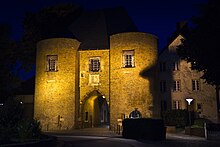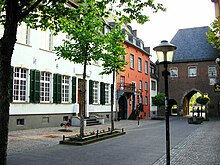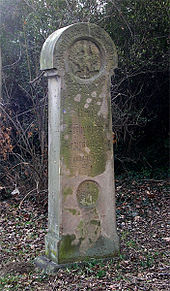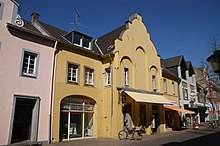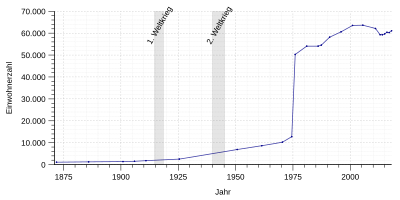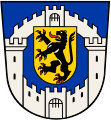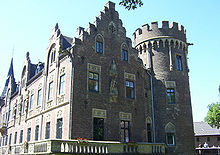Bergheim
| coat of arms | Germany map | |
|---|---|---|

|
Coordinates: 50 ° 57 ' N , 6 ° 38' E |
|
| Basic data | ||
| State : | North Rhine-Westphalia | |
| Administrative region : | Cologne | |
| Circle : | Rhein-Erft district | |
| Height : | 72 m above sea level NHN | |
| Area : | 96.34 km 2 | |
| Residents: | 61,601 (Dec. 31, 2019) | |
| Population density : | 639 inhabitants per km 2 | |
| Postcodes : | 50126, 50127, 50129 | |
| Primaries : | 02271, 02272, 02238 | |
| License plate : | BM | |
| Community key : | 05 3 62 008 | |
| LOCODE : | DE BHM | |
| City structure: | 15 districts | |
City administration address : |
Bethlehemer Strasse 9–11 50126 Bergheim |
|
| Website : | ||
| Mayor : | Volker Mießeler ( CDU ) | |
| Location of the city of Bergheim in the Rhein-Erft district | ||

Bergheim is the district town of the Rhein-Erft district in North Rhine-Westphalia . It was created in 1975 as a result of the Cologne Act from the merger of the city of Bergheim with the municipalities of Niederaußem , Oberaußem-Fortuna , Hüchelhoven, Quadrath-Ichendorf and Paffendorf as well as parts of today's city of Elsdorf and the city of Bedburg .
geography
Geographical location
Bergheim is about 20 km as the crow flies west of Cologne at about 72 m above sea level. NHN . The highest peak is the elevation Heimer with overburden of lignite degradation heaped Glessen height with 205.8 m above sea level. NHN . The foothills of the villa ridge stretch between the city center and the northern parts of the city . The Erft flows through Bergheim . The city is located in the Zülpicher Börde , which in turn belongs to the Cologne Bay . In terms of economic geography , Bergheim is in the Rhenish lignite district .
Neighboring cities
| Grevenbroich | Rommerskirchen | Pulheim |
| Bedburg |

|
Cheeky |
| Bedburg / Elsdorf | Elsdorf | Kerpen |
Waters
Flowing waters
Bergheim is located on the Erft , which divides into several side arms in the urban area: Große Erft, Kleine Erft and Erft Canal. These arms were created to drain the originally swampy land. The Erft is passable for canoes from Bergheim. The Gillbach is next to the most important Erft Bergheim rivers. It rises in the Auenheim district and joins the Erft near Neuss. Furthermore, the Wiebach, the Elsdorfer Fließ and the Glessener Bach flow through Bergheim.
Lakes
The Peringsmaar lies between Bergheim and Bedburg . It is part of the recultivated areas of the Fortuna / Garsdorf open-cast lignite mine .
City structure
Expansion of the urban area
The urban area has an area of 96.33 square kilometers.
Districts and residents
Bergheim consists of the city center and 14 districts: Ahe , Auenheim , Büsdorf (first mentioned in 893), Fliesteden (first mentioned in 1134), Glesch , Glessen , Kenten , Niederaußem (first mentioned in 969), Oberaußem (first mentioned in 969), Quadrath-Ichendorf (most populous district) , Paffendorf (first mentioned in 882), Rheidt-Hüchelhoven , Thorr and Zieverich (first mentioned in 898).

| District | Residents |
|---|---|
| Ah | 3,847 |
| Auenheim | 468 |
| Bergheim-Mitte | 6,280 |
| Büsdorf | 1,333 |
| Fliesteden | 2.017 |
| Glesch | 2.002 |
| Glessen | 5,628 |
| Kenten | 7.150 |
| Niederaussem | 5,751 |
| Oberaussem | 5,812 |
| Paffendorf | 1,247 |
| Quadrath-Ichendorf | 14,699 |
| Rheidt-Hüchelhoven | 1.928 |
| Torr | 2,220 |
| Zieverich | 4,768 |
| Bergheim as a whole | 65,150 |
As of June 30, 2019 residents with main residence
history
Prehistory and early history
Various finds document early settlements in the Bergheim area as early as 4000 BC, especially in the northern parts of the city. At Niederaussem there was a burial mound field that fell victim to the opencast mine. Around 50 BC the Romans settled in the area around Bergheim. The Roman trunk road from Cologne to Boulogne-sur-Mer / Bonen ( Gesoriacum ), now known as Via Belgica , ran over the area of today's Bergheim. After the Romans, the Franks took over the Erftland. At that time Bergheim was in the border area between Gillgau , Kölngau and Jülichgau .
middle Ages
Bergheim is first mentioned in a document from the year 1028 (some districts but much earlier) in which Hezelin, the brother of the Count Palatine Ezzo , which belongs to him manorial Bergheim, who was formerly a royal estate, the Kornelimünster Abbey gave away. Until the end of the Old Kingdom, the Abbey on the Inde remained in the possession of the lordship of Bergheimerdorf, to which most of today's town belonged.
The bailiwick of the Bergheim manor had been exercised by the Counts of Jülich since the 13th century . They built a castle here. Bergheim developed from the castle settlement. Bergheim received city rights around 1300 . The Cologne – Aachen trunk road was laid directly through the city center. In the Middle Ages, Bergheim was a customs and mint for the dukes of Jülich and a market town.
In the Middle Ages the city of Bergheim was secured by two city gates and a wall. The Aachen Gate and parts of the wall with towers are still preserved today.
A receipt from Duke Gerhard von Jülich-Berg for his Landrentmeister zu Jülich from 1440 shows that there was a meeting of the Duke with the Archbishop of Cologne, Dietrich II von Moers , and Count Friedrich IV that year in Bergheim . came from Moers . Gerhard's son, Duke Wilhelm von Jülich-Berg, also visited Bergheim. On June 27, 1492, he issued a certificate here in which he complained to Count Vincenz von Moers that one of Wilhelm's servants at customs had been troubled . With Vincenz's successor, Count Wilhelm II von Wied-Runkel-Moers , Duke Wilhelm von Jülich-Berg arranged a day trip to Bergheim on August 17, 1494 to deal with any issues . At that time Bergheim seems to have been a preferred place for consultations with the Dukes of Jülich-Berg.
To the north of the fortified city, along one of the Erftgräben, lay the parish Bergheimerdorf, which formed its own manor. The abbot of Kornelimünster had the right to appoint the church.
Modern times
In 1542 the city was largely destroyed as a result of the warlike turmoil between the sovereign and Emperor Charles V. Bergheim was unable to regain its old significance until the 19th century. After the end of the old empire and the transition to France , Bergheim became the capital of the canton of the same name in the Département de la Roer , after the invasion of the Prussians in 1816 the county seat . Bergheim thus remained the higher-level administrative center. A new boom in the city began with industrialization in the 1890s. In particular, the lignite mines near the city and the connection to the Rhenish railway network made a significant contribution to urban development. As early as 1935, more people were working in large industrial companies - such as lignite and chemical plants - than in agriculture and other trades.
During World War II , Bergheim suffered greatly from bombing by the Allies and from the fighting during the occupation in March 1945. A total of 4.2 percent of the residential buildings were completely destroyed, 11.8 percent seriously and 37.6 percent slightly damaged. After the war, Bergheim took in more than 5,000 refugees, mainly from the eastern regions, which greatly changed the denominational and social composition of the population.
The formation of the Bergheim office from the merger of the Bergheim and Paffendorf offices and the Hüchelhoven municipality in 1937 created the administrative prerequisites for the strong population and economic growth in the post-war decades. From 1945 to 2005 the population more than tripled. In 1958, the Wiedenfeld community came to Bergheim, which had to be relocated because of the Fortuna / Garsdorf open-cast lignite mine . In the 1980s, another place disappeared from the Bergheim map. The Fortuna miners' settlement belonging to Oberaussem was dissolved, some of the residents were distributed to company apartments throughout the Rhein-Erft district, while others received grants for building new homes in other places.
Since the municipal reorganization in 1975, Bergheim has consisted of 15 districts, is the seat of the Rhein-Erft district and numerous administrations. Along with Kerpen, it is the most populous municipality in the Rhein-Erft district.
Incorporations
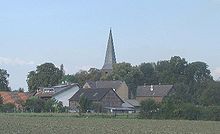
In 1938 the communities Kenten and Zieverich were incorporated. On April 1, 1958, Wiedenfeld was added. On January 1, 1975, the communities of Glesch, Niederaußem, Oberaußem-Fortuna, Quadrath-Ichendorf, Paffendorf and Rheidt-Hüchelhoven as well as part of the city of Bedburg (Auenheim), parts of the municipality of Elsdorf (Ahe and Thorr) and the municipality of Hüchelhoven (Büsdorf , Fliesteden and Glessen).
Population development
In the Middle Ages and early modern times , Bergheim was only a small town with a few hundred inhabitants. The population grew only slowly and fell again and again due to the numerous wars, epidemics and famine. Due to industrialization in the 20th century, population growth accelerated. In 1900 there were only 1,400 people living in the city; in 1950 there were already 6,900. Even after that, the population continued to grow. In 1970 Bergheim had 10,225 inhabitants.
The incorporation of numerous places on January 1, 1975 brought an increase from 36,325 people to 49,457 inhabitants. In 2002 the population reached its highest level to date with 63,728. On June 30, 2005, the “ official number of inhabitants ” for Bergheim was 63,639 according to updates by the State Office for Data Processing and Statistics North Rhine-Westphalia (only main residences after comparison with the other state offices).
The following overview shows the number of inhabitants according to the respective territorial status. These are census results (*) or official updates from the State Statistical Office. From 1871, the information relates to the “local population”, from 1925 to the resident population and since 1987 to the “population at the place of the main residence”.
|
|
|
politics
City council
The city council is the municipal representative of the people of Bergheim. The citizens decide on the composition every five years. The last election took place on May 25, 2014.
mayor
Mayor of the city is Volker Mießeler (CDU).
In each district there is a local mayor who represents the interests of the citizens in relation to the city council, the city administration and other authorities. The right to propose the office of mayor is held by the party that received the most votes in the town in the most recent local elections. The local mayor is elected by the city council. The local mayor of Bergheim-Mitte was Friedhelm Henze from the CDU from 2009 to 2014. After the municipal elections in 2014, the SPD could have appointed the local mayor. The Bergheim-Mitte district and its mayor were abolished by the city council in 2014. There are now 14 neighborhoods.
Town twinning
Bergheim is twinned with Chauny in France and Andenne in Belgium . Bergheim pupils regularly visit the two twin cities and vice versa. The organization of the ABC sports festival, which takes place in one of the three partner cities every year, has developed into a tradition. (ABC stands for Andenne-Bergheim-Chauny.)
The Niederaussem district has been in partnership with Briey in Lorraine ( France ) since 1958 .
Aircraft sponsorship
On September 16, 2008 was Airbus 321-200 of Lufthansa on the name "Bergheim" baptized. The district town of Bergheim is the 54th town in North Rhine-Westphalia to have adopted an aircraft sponsorship. The mayor Maria Pfordt was the godmother. In addition, Mayor Maria Pfordt christened the newly purchased ASK 21 of the Erftland air sports club with the name “Stadt Bergheim” in 2006 .
Coat of arms, banner and flag
coat of arms
Blazon : "In blue a silver (white) ring-shaped city fortification, each bounded by a three-pinned tower with two black window openings, at the top and bottom a three-pinned gate opening with a black portcullis, each connected by a crenellated wall with the side towers, the lower city wall in front and two window openings at the rear; in the middle covered with a small golden (yellow) shield, in it a black, soaring, red-armored and tongued lion. "
The city of Bergheim has a coat of arms, a seal and a flag (banner and flag). The prints and the descriptions are attached to the main statutes as Annexes 2–5. The city coat of arms has its origin in a jury's seal from the 14th century. It shows the city wall with towers and gates of the old city, which has had city rights since 1317. The black lion stands for the former membership in the Duchy of Jülich.
flag
As a banner: "The city of Bergheim carries a banner with the colors" yellow-black "with the city coat of arms in the middle field." As a hoisted flag: "The city of Bergheim has a city flag with the colors" yellow-black "with the city arms in the middle field."
Culture and sights
Museums
- Pipe museum in the Niederaussem district
- Mauseum (2,500 mouse objects) in the Glessen district
- Pianomuseum Haus Eller ( Verlag Dohr ), in the district of Ahe
- Paffendorf Castle with information center lignite , educational trail on lignite vegetation in the castle park belonging to the street of garden art between the Rhine and Maas and the street of energy
- Private mining museum in the Niederaußem district
- Historical Museum of the City of Bergheim on the inner city pedestrian zone, near the hospital (opening on March 31, 2012, in the year of the 700th anniversary)
Buildings
List of architectural monuments
The list of architectural monuments in Bergheim contains the listed architectural monuments in the area of the city of Bergheim in North Rhine-Westphalia (as of April 2010). The basis for the admission is the Monument Protection Act of North Rhine-Westphalia (DSchG NRW).
Palaces and castles
Schlenderhan Castle around 1860, Alexander Duncker collection
Paffendorf Palace around 1860, Alexander Duncker collection
Frens Castle around 1860, Alexander Duncker collection
- Upper Castle / Lower Castle ( Fliesteden )
- Geretzhoven Castle near Hüchelhoven
- Paffendorf Castle ( Paffendorf )
- Schlenderhan Castle (Quadrath-Ichendorf)
- Frens Castle (Quadrath-Ichendorf)
- Ruin Haus Laach (Thorr)
- House Thorr (Thorr)
- Holtrop Castle (Niederaussem)
- Zieverich Castle
Courtyards and estates
- Gut Meulshof (Niederaussem)
- Gut Groß-Mönchshof (Rheidt)
- Gut Klein-Mönchhof (Niederaussem)
- House Wiedenau, ( Ahe )
- Millianshof (Rheidt)
- Gut Asperschlag (Niederaussem)
- Ordenshof in Auenheim
- Büsdorf windmill
- Gut Neuhof ( Glessen )
- Broichshof (Glessen)
- Schlenderhan and Pliesmühle stud farms (Quadrath-Ichendorf)
Sacred buildings
Church of the Redeemer in Niederaussem
St. Johann Baptist in Niederaussem
St. Pankratius in Paffendorf
- Christ Church Bergheim- Zieverich
- Parish Church of St. Remigius (Bergheim) (Bergheim Mitte)
- St. Hubertus Bergheim- Kenten
- City Chapel St. Georg (Bergheim Mitte)
- St. Medardus (Bergheim- Auenheim )
- St. Pankratius (Bergheim-Glessen)
- St. Laurentius (Bergheim- Büsdorf ) with a Romanesque crucifix
- St. Cosmas and Damian (Bergheim- Glesch )
- Church of the Redeemer (Niederaussem)
- St. Johann Baptist (Niederaussem)
- St. Paulus (Niederaussem)
- St. Vinzentius ( Oberaussem )
- St. Michael ( Hüchelhoven )
- St. Laurentius (Quadrath) ( Quadrath-Ichendorf )
- Holy Cross (Ichendorf)
- St. Pankratius (Paffendorf)
- St. Simon and Jude Thaddäus ( Torr )
- Petrikirche ( Quadrath-Ichendorf )
- St. Michael (Ahe)
Other monuments and sights
- Aachen Gate
- Old gate guard
- historical town hall
- Cologne Gate
- Niederaussem power plant
- Roman Tower ( Torr )
- New city gate
- city wall
- Windmill (Büsdorf)
- Villa Pechstein
- Brauhaus In der Cronen
- George's Chapel
- History fountain
- Hauptstrasse 45
- Beisselstrasse 5
- Calvary
- Reclamation Tree
- Bahnstrasse 12
- Glacier boulders
- Spherical triangle
- Turn of the century house
- Gasthaus Zur Post
- House Roleff
- Domackerstrasse 71
- Stallion sculpture oleander
- Glassmaker's fountain
- Memorial in Quadrath-Ichendorf
- Barbara Chapel
- Parish Church of St. Hubertus
- Kenten mill
- Roman brewery
- Villa Klara
- Old rectory
- Locksmith's house
- Römerstrasse 12
- Zievericher Strasse 2
- Hauptstrasse 26
- Hauptstrasse 39
- Hauptstrasse 40
- Hauptstrasse 47
- Hauptstrasse 69
- Main street 71
- Hauptstrasse 97
- Hauptstrasse 98
- Saint Nepomuk
- War memorial
- Hauptstrasse 110 and 108
- Hauptstrasse 106
- Hauptstrasse 99
- Over-home
- Bartholomäus Ehlen House
- The ark
- Play and adventure fountain
- Statue of Saint Nepomuk
- Schützenstrasse 5
- Water vortex fountain
- Sculpture mother with son and daughter
- Kirchstrasse 18
- Villa sapphire
- Graf-Otto-Strasse 38
- Domackerstrasse 54
- Cologne-Aachener-Strasse 81
- Quadrath-Ichendorf station
- Historic briquette press
- Holy Cross Church
- Havaria area
- Pliesmühle
- Marienburg
- Josefshaus
- Kenten crossroads
- Römerstrasse 8
- Valderhof
Jewish cemeteries
- Old cemetery on Knüchelsdamm: 18th century (extended in 1804) to 1862. Acquired by the Jewish community in 1818, the old Bergheim cemetery came into the possession of the city of Bergheim in two stages in 1938 and 1942. Before the Second World War, there are said to have been 15 tombstones on the burial site, three of which were brought to the new cemetery on Bethlehemer Strasse, the whereabouts of the remaining stones are unclear. Seven graves were found during construction work on Knüchelsdamm in 1980. About 80 graves are said to still be in the old cemetery.
- New cemetery Bethlehemer Straße: 1862–1933, 52 tombstones
- Cemeteries in Glesch, Glessen, Paffendorf are described under the respective districts.
Regular events
With the culture and media center Medio.Rhein.Erft , Bergheim owns a modern event center.
In Bergheim and its districts, a lively tradition has been preserved, mainly represented by carnival and shooting clubs.
Economy and Infrastructure
History of the lignite industry
The town of Bergheim looks back on a long tradition in lignite mining.
Mining played an important role, especially in today's districts of Niederaußem and Oberaußem. The Niederaussem power plant and the Fortuna-Nord coal refining company are evidence of this.
Emergence
Lignite originated within the Tertiary in a period from 25 to about 5 million years ago. At this time in the history of the earth there was a sedimentation area on the northern edge of the Rhenish Slate Mountains , which has sunk almost continuously over the past 30 million years. Therefore, the geology of the Lower Rhine Bay today is characterized by deposits from the North Sea as well as sand and gravel from rivers that flowed through this depression. In large periods of time, subtropical forest and moor vegetation was able to spread, also benefiting from extensive groundwater resources . Organic material that got under the exclusion of air in the water no longer rot. It was hermetically sealed by the water so that peat could form. Thanks to the continuous subsidence of the Rhineland, thick layers of peat were created. In the Bergheim area, the peat reached thicknesses of up to 270 meters (the so-called main seam group).
Over the millions of years the climate became colder. Much water was bound in glaciers during the cold ages, so that the sea level sank worldwide. The North Sea withdrew from the Rhineland northwards into the Netherlands . Above the peat layers, rivers such as the Rhine , the Rur and the Meuse mainly deposited sand and gravel. This compacted the peat and gave off water. Under the pressure of the deposits, today's lignite was created through coalification processes . The Rhineland received its present-day appearance through four ice ages. The typical plants from the lignite period - as far as they tolerate today's temperate climate - were planted in an educational trail in the park of Paffendorf Castle , the information center lignite of the RWE Power company .
First brown coal discoveries
The "finished lignite" and its combustibility were probably first recognized by the Romans . When building a water pipeline near Frechen , they must have hit the coal at a shallow depth. This was probably the first documented seam fire in the history of the Rheinische Revier. The Romans did not mine coal.
Lignite was also mined in the Middle Ages. But they were mostly only used as a Cologne umber , as a color.
It was not until the end of the 17th century that workers from the ceramics industry between Bonn and Frechen noticed that the "black earth" they found in the clay pits above the clay layers could burn. The first small pits were built in the southern district near Brühl and Hürth .
Lignite mining in Bergheim
In the area of Niederaussem the first pits were not built until the beginning of the 19th century. The Niederaussem farmer Meul came across coal while working in a field near Oberaussem and then opened the first mine. A short time later, the first mountain damage was to be lamented, the old Schlenderhan Castle near Quadrath-Ichendorf collapsed.
In 1870, Meul had to sell the mine and the new owner was Simon von Oppenheim, who also owned the neighboring Schlenderhan mine near Quadrath.
A year after the mine was bought, a major innovation found its way into the mine. The overburden and coal were loaded onto wagons, which were then pulled out of the open pit with a winch. The first briquette factory with seven presses went into operation in 1882 . Oppenheim's son Eduard took over the management after the death of his father and merged the Schlenderhan, Urwelt and Fortuna mines. Shortly before the beginning of the 20th century, the Fortuna union was founded, an association of several mine owners. At the same time, the Fortuna I briquette factory went into operation near Oberaussem. Only one year later, in 1900, work began on a second factory, which was already producing a year later. Every year 210,000 tons of briquettes could be produced here.
On the way to big industry
Briquette production took a back seat in the following years. Lignite was now used to generate electricity .
The city of Cologne grew steadily around the turn of the century and needed electricity. Therefore, the first Fortuna power plant was built between 1910 and 1912 .
After the construction work was completed, Fortuna I delivered 32 megawatts of electricity. Fortuna II power plant also went into operation a good ten years later. In 1941, large-scale industry also moved into Niederaussem and Auenheim. The Fortuna-Nord briquette factory, today the Fortuna-Nord coal refining company , on the border between Niederaussem and Auenheim began production.
After the Second World War
During the Second World War, the industrial plants were repeatedly targeted by Allied air raids. Despite the damage, electricity could be produced again on Fortuna from December 1945.
In the following years things picked up again. In 1955 the first large open-cast mine was built in the Rhenish lignite mining district, the Fortuna-Garsdorf open-cast mine . For years this was the largest opencast mine in the world. Here the RAG and later the Rheinbraun used the most modern conveyor equipment.
But this also meant the relocation of the places Garsdorf, Frauweiler and Wiedenfeld . The Wiedenfelder found their new home in Bergheim-Mitte. Frauweiler and Garsdorf were rebuilt in ( Bedburg -) Rath.
Another part of the power plant was added at the Fortuna site in the 1950s. The briquette factories were shut down and demolished.
Due to the increasing demand for electricity, work on the Fortuna IV power plant began in 1961, but not at the Fortuna location, as the name suggests, but in Niederaussem. In the 1970s, the opening of the Bergheim opencast mine was announced, associated with the closure of the three Fortuna power plants and the relocation of Fortuna .
The end of the lignite industry in Bergheim came in the 1980s. The village of Fortuna disappeared and on December 22, 1988 the Fortuna power plant was finally taken off the grid. Demolition work began in 1989.
Since 1990
In 1993 the last coal was mined in the Fortuna-Garsdorf opencast mine. On July 4, 2002, the Bergheim opencast mine was also depleted. Recreational areas for the residents of the surrounding areas have emerged from the former open-cast mining areas.
In 1997, work began on the new BoA block with an output of 944 megawatts at the Niederaussem power plant . In the summer of 2002, then Federal Chancellor Gerhard Schröder put the lignite power plant with optimized system technology into operation at a ceremony. In 2012, the BoA-2 and BoA-3 power plants, each with an output of 1,060 megawatts, went into operation at the Neurath location .
The coal is brought in by RWE's own railway lines, the Hambachbahn , from the Hambach opencast mine and the North-South Railway (Garzweiler) from the Garzweiler opencast mine .
RWE and the Rheinbraun successor company RWE Power are currently planning a further power plant block (BoA-4) in Niederaussem.
Information: At the information center at Schloss Paffendorf, the themed street “Straße der Energie” begins , which shows the most important and most modern areas of the lignite industry and the recultivation of the area together with wind energy and photovoltaics in stations.
Economy (current)
Bergheim has above-average purchasing power and offers over 22,000 jobs. The largest employer in the area is RWE Power . It operates lignite mining in the area and is the largest energy supplier in North Rhine-Westphalia.
The Martinswerk in Quadrath-Ichendorf was founded in 1913 as a subsidiary of Aluminum Industrie AG . In the Martin plant the necessary was for the aluminum smelters of AI AG aluminum oxide , also called alumina hut made. Since large quantities of steam power were required for production, the choice of location fell on Bergheim, as it is located in the heart of the Rhenish lignite mining area. Today, Martinswerk is one of the world's most important suppliers of products based on aluminum hydroxide and aluminum oxide. In 2001 it was bought by the Albemarle Corporation .
Between 1997 and 2002 another power plant block was built in the Niederaussem district at the existing Niederaussem power plant. Up to 2,000 workers were employed in Bergheim. The construction cost of 1 billion euros was the largest single investment in North Rhine-Westphalia at the time.
In the district Paffendorf are a logistics center and the seat of Germany branch of the British, the 250 FTSE listed online - mail order company AO World plc .
traffic
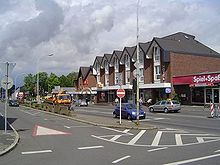
Rail transport
The Erftbahn ( KBS 481 ) runs through Bergheim from Neuss to Horrem (on the main Cologne – Aachen line). The route is operated as the RB 38 (Bedburg - Bergheim - Horrem - Cologne). It is operated by DB Regio .
old trainstation
The old train station opened in 1988. Parts of the building / reception hall served as a restaurant. In the rear area there was a Deutsche Bahn ticket office until around 2010. Right next to it was the waiting area. There was seating there. There was also storage space here. The station building was cleared in 2015/2016 as a shopping center is being built on the station site. A shopping area of up to 10,000 square meters is planned there. The old bus station with waiting room next to the former kiosk has already been demolished (as of October 2016). The new bus station with the planned shopping center is due to open at the end of 2018.
Bus transport
- At the Bergheim bus station, the Rhein-Erft-Verkehrsgesellschaft bus lines run from Bedburg (line 975), Rommerskirchen (line 971), Cologne- Weiden (lines 950 and 961), Frechen and Hürth (line 960), Horrem (lines 960 and 975), Buir (line 939), Elsdorf (lines 937 and 950) and Titz -Rödingen (line 950) together
- The bus station is also the end of the line 922 Bergheim– Kerpen operated by Tirtey.
- The neighboring town of Pulheim can only be reached from the northern parts of the city (e.g. Niederaussem) without having to change trains with the 970 bus.
- Local traffic in Bergheim-Mitte, Kenten and Quadrath-Ichendorf is also handled by city traffic line 969 (only Monday to Friday from 9 a.m. to 11:30 a.m. and 2 p.m. to 5 p.m.)
- In school traffic, there are also many additional trips under line number 923 to the stops near the secondary schools
- A collective call taxi system supplements this offer.
Road connection
- Bergheim is directly connected to the Autobahn 61 , which runs from the Hockenheimring near Speyer via Koblenz to Venlo . The A 61 is connected to the A 4 via the Kerpen motorway junction .
- The federal highways 55 and 477 also run through Bergheim's urban area. The road network is supplemented by numerous country and district roads.
Bike paths
The city is connected to several cycle routes:
- The 524 km long moated castle route connects more than 130 castles on the edge of the Eifel and in the Cologne Bay .
- The 265 km long cycle path network of the valley route opens up interesting tourist spots in North Rhine-Westphalia on a family-friendly route.
- The Erft cycle path runs along the Erft for around 110 kilometers . From the source in Nettersheim - Holzmülheim to the confluence with the Rhine in Neuss .
media
The Kölner Stadt-Anzeiger and the Rhein-Erft-Rundschau ( Kölnische Rundschau ) are each represented by a local editorial office in Bergheim, which reports on events in the district town on weekdays. The advertising mail appears on Wednesdays and the Sunday mail appears on Saturdays. Both sheets are free and sponsored by advertising.
The “Shopping News” advertising paper appears free of charge once a month in Bergheim, Bedburg, Elsdorf and Kerpen.
The local radio station Radio Erft , located in Wesseling and broadcasting systems on the Colonius in Cologne, provides information about Bergheim and the cities of the Rhein-Erft district .
Important events are reported in "Kölner Lokalzeit" on WDR television and in the regional news from WDR 2 .
Educational institutions
Libraries

The city of Bergheim has several libraries and libraries. The largest and most modern is the city library in the center of Bergheim. It was reopened in June 2004 after moving to Medio.Rhein.Erft .
Other former municipal libraries have now become the responsibility of schools and other institutions. The former Niederaußem / Oberaußem public library is operated by the Albert Einstein Realschule and the Oberaußem district forum. In Quadrath-Ichendorf, the comprehensive school is in charge and in Ahe local residents look after the facility on a voluntary basis.
In addition to the municipal library and the semi-public libraries in the districts, the Catholic parishes also operate public libraries in most of the districts.
schools
Bergheim has 12 primary schools, two grammar schools ( Erftgymnasium and Gutenberg-Gymnasium Bergheim ) in the city center, two secondary schools in Oberaußem and Bergheim and a comprehensive school in Quadrath-Ichendorf and two secondary schools.
The vocational college of the Rhein-Erft district with a focus on nutrition and supply management, the food industry, personal care and social and health services has both locations in Bergheim.
A specialist seminar for care for the elderly (Institute for Care and Social GGmbH) offers three-year training in care for the elderly in several courses.
In the Niederaußem district there is a special school with a special focus on learning for children with learning disabilities.
The local adult education center (VHS) offers adult learning opportunities; The various school-leaving qualifications can be made up at the Bergheim evening school.
Personalities
Honorary citizen
The city of Bergheim has the following honorary citizens who have rendered outstanding services to the city in the following functions:
- Willi Abts, member of the Bergheim City Council and Deputy Mayor
- Rudi Bittner, member of the Bergheim City Council, member of the district council of the Erftkreis and 1st mayor of Quadrath-Ichendorf
- Peter Giesen, member of the Bergheim City Council and Mayor of Ahe
- Klaus Gülden, member of the Bergheim City Council and mayor of Auenheim
- Richard Kasper, member of the state parliament, mayor of the community of Quadrath-Ichendorf and district administrator of the Bergheim district
- Rolf Kremer, member of the Bergheim City Council and mayor of Niederaussem
- Hubert Orth, member of the Bergheim City Council
- Willi Roth, member of the Bergheim City Council
- Willi Schmitt, member of the Bergheim City Council and honorary mayor of Bergheim
- Alfred Timm, services to the Bergheim-Chauny town twinning
- Willi Weck, member of the Bergheim City Council and Mayor of Oberaußem
- Peter Weitz, member of the Bergheim City Council and Mayor of Glesch
- Hans Wolle, member of the Bergheim City Council, mayor of the former Niederaußem municipality
Traditionally, members of the city council who have served on this body for 30 years are awarded honorary citizenship.
sons and daughters of the town
- Carl Gisbert Wilhelm von Bodelschwingh-Plettenberg (1821–1907), landowner and politician
- Cornelius Trimborn (1824–1889), lawyer and member of the German Reichstag
- Aegidius Müller (1830–1898), Catholic pastor and author
- Alfred Overmann (1866–1946), historian and director of the Erfurt City Archives
- Christian Junggeburth (1887–1929), cyclist and pacemaker
- Gerhard Fieseler (1896–1987), fighter pilot in the First World War and aircraft designer (Gerhard-Fieseler-Werke)
- Heinrich Ernst Siegrist (1903–1970), writer
- Albert Zimmermann (1928–2017), historian of philosophy
- Dieter Höller (1938–2013), football player
- Christian Breuer (1939–2017), football player
- Horst Hoffmann (* 1950), writer
- Paul Vincent (1950–2016), musician, composer and arranger
- Karin Graf (* 1952), literary agent and translator
- Wolfgang Seifen (* 1956), organist and professor
- Thomas Licher (* 1963), journalist
- Alfred Steffen (* 1963), photographer
- Sarah Kreuz (* 1989), singer, runner-up at DSDS
- Victoria Ulbrich (* 1992), singer and former band member of Queensberry
Personalities who have worked here
- Peter Bongartz (* 1942), actor, lives in Bergheim for years.
- Daniel Engelbrecht (* 1990), German professional footballer, who was the first to score a goal with the handicap defibrillator
- Günter Grass (1927–2015): The writer lived in Bergheim-Oberaussem for a few years after the end of the Second World War. In his novel Die Blechtrommel (1959) he lets his hero Oskar Matzerath look at the Erft landscape from the Oberaussemer Friedhof, especially the "hissing, always about to explode Fortuna Nord power station".
- Stefan Heße (* 1966), Archbishop of Hamburg, was chaplain of St. Remigius in Bergheim from 1993 to 1997.
- Wilhelm Hoffsümmer (* 1941): The Paffendorf pastor Wilhelm "Willi" Hoffsümmer published numerous books, including Nikos Traum (1983) and Gott ist mit David (1986).
- The sculptor Heinz Klein-Arendt , who was born in Cologne in 1916, lived and worked in the Bergheim district of Oberaußem from 1971 until his death on July 15, 2005. Among other things, he designed the stained glass windows of the Erlöserkirche in Niederaussem in 1980 and created various sculptures and sculptures for public spaces, such as a group of figures for Hubert-Rheinfeld-Platz in Bergheim's city center in 1981.
- The painter and art professor Dieter Krieg , who was born in Lindau on Lake Constance in 1937, lived in the Quadrath-Ichendorf district of Bergheim until his death on November 26, 2005. He was a main exponent of figurative expressionism. In 1978 he represented Germany at the Venice Biennale.
- Axel Kutsch (* 1945) published poetry anthologies in which, in addition to lesser-known poets, Büchner Prize winners such as Durs Grünbein , Ernst Jandl and Hans Magnus Enzensberger have their say. Both his anthologies and his volumes of poetry (including collapse risk , 1997, word break , 1999, Ikarus drives omnibus , 2005) met with a positive response. Axel Kutsch, who lives in Bergheim-Ahe, has also edited several regional reading books.
- Kay Löffler (* 1958), north German writer, lived in Bergheim-Niederaussem between 1987 and 1992. The local coal-fired power station and the region's environmental problems inspired him to write his novel Village of Cloud Makers .
- Rupert Mayer has published several books to date (including the poetry volumes Gewisse Menschen , 1984, and Defoliated Time , 1986).
- Gynter Mödder (* 1942): Bergheim-Glessen is the hometown of the nuclear medicine doctor , from whom, in addition to non-fiction and specialist books, the novels Tiefgang, der Mäusephilosoph (1986), Let me live! (1996) and Gulliver's Fifth Journey (2005).
- Christian Müller (* 1938), German professional footballer until 1966, with 1. FC Köln and Karlsruher SC, lived in Rheidt
- Karl Rovers: The former headmaster from Quadrath-Ichendorf published the volume of poetry Chile im Netzwerk (1988), a children's book and several non-fiction books.
- The soccer player Lukas Podolski grew up in Bergheim and played in the youth team of FC Jugend 07 Bergheim from 1991. In 1995 he moved to the D-Jugend of 1. FC Köln ; there he later became a professional player. In 2006 he was voted the best young player in the World Cup . From the 2006/07 season he played for FC Bayern Munich. In 2009 he returned to 1. FC Köln, moved to Arsenal in 2012 and to Galatasaray Istanbul in 2015 .
- The dancer, ballet master and dance teacher Peter Roleff was born in 1906 in Quadrath-Ichendorf. He died in Neubeuer / Upper Bavaria in 1994. Roleff had engagements at the Städtische Oper Berlin, Augsburg, Duisburg, Bonn and Wiesbaden. He also appeared in the films The Congress Dances , Clothes Make the Man and The Mail Goes With You . In 1960 his ballet Diana Sorpresa (music by Harald Banter ) was broadcast on German television .
- Michael Schumacher (* 1969), Formula 1 racing driver and seven-time world champion, attended the Geschwister-Scholl-Realschule in Bergheim and lived for a few years in Niederaussem and in Quadrath-Ichendorf, where he also attended kindergarten and elementary school.
- Lukas Sinkiewicz (* 1985), German professional footballer (VfL Bochum, 1. FC Cologne, Bayer 04 Leverkusen)
- Manfred Stock (* 1932), Fliesteden (1970–1995) was chairman of the NABU Rhein-Erft-Kreis for 22 years . In 1986 he received the Federal Cross of Merit on ribbon.
- Henner Voss wrote his book Before the Journey - Memories of Bernward Vesper (2005) in Bergheim . In it he describes his friendship with Gudrun Ensslin's partner from 1961 to 1965. In addition to his memory book, Voss has published reports, author portraits and stories. His story Lukas was filmed in 1985.
Michael Schumacher (2005)
literature
- to the monuments in the districts of Bergheim:
- Rhenish Association for the Preservation of Monuments and Heritage Protection (Ed.): The Rhenish brown coal area. A landscape in need , Neuss 1953.
- Annaliese Ohm, Albert Verbeek: The monuments of the Rhineland. Bergheim district . Düsseldorf 1971, ISBN 3-508-00186-5 .
- Hans Erich Kubach, Albert Verbeek: Romanesque churches on the Rhine and Maas . Rheinischer Verein für Denkmalpflege, Neuss 1971, p. 336 and Fig. 139.
- Hermann Hinz : Archaeological finds and monuments of the Rhineland. Volume 2: Bergheim district . Düsseldorf 1969.
- Parish council of St. Remigius (Ed.): St. Remigius Bergheim / Erft 1175–1975 . Bergheim 1976.
- 175 years of miraculous image in St. Remigius, Bergheim . Bergheim 1978 (therein references).
- Richard Klapheck : The art of architecture on the Lower Rhine . Volume 2. Art Association for the Rhineland and Westphalia, A. Bagel, Düsseldorf 1915/16, p. 83 and Fig. 8.
- Heinz Andernach, Helmut Schrön, Hein Braschoß, Ralph Jansen, Cornelia Breuer: Collective edition Bergheimer Stadtführer , 3 vol., District town Bergheim Economic Development, City Marketing, Tourism (Ed.), 2014, Vol. 1 pedestrian zone, ISBN 978-3-9801975-8 -8 , Vol. 2 Ortsteile ISBN 978-3-9801975-7-1 , Vol. 3 Ortsteile, ISBN 978-3-9801975-6-4
Individual evidence
- ↑ Population of the municipalities of North Rhine-Westphalia on December 31, 2019 - update of the population based on the census of May 9, 2011. State Office for Information and Technology North Rhine-Westphalia (IT.NRW), accessed on June 17, 2020 . ( Help on this )
- ↑ LAV NRW, Rhineland Department , Jülich-Berg I, 1286.
- ↑ LAV NRW, Rhineland Department, Jülich-Berg I, 327.
- ↑ LAV NRW, Dept. Rhineland, Jülich-Berg, lit. n. 607.
- ↑ Martin Bünermann: The communities of the first reorganization program in North Rhine-Westphalia . Deutscher Gemeindeverlag, Cologne 1970.
- ↑ Martin Bünermann, Heinz Köstering: The communities and districts after the municipal territorial reform in North Rhine-Westphalia . Deutscher Gemeindeverlag, Cologne 1975, ISBN 3-555-30092-X , p. 185 .
- ^ District town Bergheim. Council election - overall result. May 25, 2014, accessed April 25, 2015 .
- ↑ photo . segelflug.de. Retrieved June 3, 2012.
- ↑ Main Statute of the City of Bergheim, § 4. (No longer available online.) Formerly in the original ; Retrieved December 27, 2012 . ( Page no longer available , search in web archives ) Info: The link was automatically marked as defective. Please check the link according to the instructions and then remove this notice.
- ^ Rhein-Erft-Kreis (Ed.): Museums and private collections on the Rhine and Erft. 2nd edition 2009, p. 14 f.
- ↑ Bernd Imgrund , Nina Osmers : 111 places in the Cologne area that you have to see. Verlag Emons, Cologne, 2010, ISBN 978-3-89705-777-7 (location 6).
- ↑ The Mining Museum - district town Bergheim ( Memento from September 23, 2012 in the Internet Archive )
- ↑ Official website of the Museum Association (sponsor) ( Memento from May 1, 2012 in the Internet Archive )
- ↑ Central archive for research into the history of Jews in Germany - Collections: Friedhofsdokumentation . uni-heidelberg.de. Retrieved June 3, 2012.
- ↑ compare to the following: Ulrich Reimann: Oberaußem - Fortuna and the brown coal . stadtteilforum-oberaussem.de. December 2006. Archived from the original on May 2, 2013. Retrieved June 3, 2012.
- ↑ Dennis Vlaminck: Bergheimer Martinswerk is to be sold. In: Kölner Stadt-Anzeiger . February 13, 2015, accessed November 21, 2015 .
- ↑ Querying the course book route 481 at Deutsche Bahn.
- ↑ Plans for the shopping center at Bergheimer Bahnhof are running out of parking spaces
- ↑ Bergheim station plans are on display
- ↑ Overview of our educational offer. Vocational College Bergheim, accessed on February 5, 2019 .
- ↑ Kickers win 2: 1: Engelbrecht makes history






